Songbirds are often beautiful, and their songs are familiar, pleasing sounds to many people! Making up almost half of all bird species in the world, songbirds are also known as “perching birds.” Their feet have three toes facing forward and one facing back, allowing them to easily grasp their perch, even while sleeping.
Male songbirds pour forth their melodies on spring mornings, and many sing from mid-winter through mid-summer. They use songs to announce their claim to nesting territories and to warn other birds of the same species to stay away. If all goes well, the irresistible combination of colorful plumage and vibrant song will attract a mate, and a nest full of young birds will be the result. Males tend to stop singing when close to the nest to avoid attracting predators. Songbirds also produce other shorter and simpler sounds known as calls, used to communicate during all seasons.
Both the male and female adults of some species take care of their nestlings. In others, only the female incubates the eggs and feeds the young. During the spring, listen for baby birds in the nest chirping aggressively when their parents are close, begging for food. Once the young birds fledge (leave the nest and start flying), they often continue to beg the adults for food through late spring and sometimes even summer.
When exploring your East Bay Regional Parks, your neighborhood, or even your backyard, it may be possible to see and hear many of the birds listed in this brochure. In whatever way you choose to study songbirds, the experience is sure to be rewarding!
- Common Songbirds - Brochure [PDF]
The following are just a few favorites among the many songbird species commonly seen and heard in the East Bay Regional Parks. Click on the songbird name links to hear their songs.

American Goldfinch
- Carduelis tristis
- Length: 4½-5”
Once referred to as wild canaries (American goldfinch and lesser goldfinch both included), goldfinches are social songsters, often traveling in flocks. The male American goldfinch is the most vivid yellow of our three local species, while the lesser goldfinch is the most common in the East Bay. Finches feed on weed seeds, flower buds, and occasionally insects. Their undulating, “roller coaster” flight pattern and tendency to sing jubilantly while aloft make them easier to identify. Often goldfinches can be attracted to residential feeding stations stocked with thistle seed.
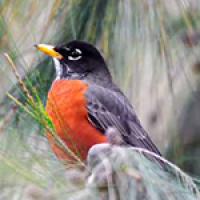
American Robin
- Turdus migratorius
- Length: 8½-10”
An all-time backyard favorite in much of North America, the robin is also widespread in undeveloped areas of California. Look for this bird in grassy patches as it hunts worms by listening for them as they leave the ground! The handsome rust-colored breast of this thrush, combined with its elegantly cheerful song (cheerily-cheeri-up-cheerio), make the robin easily identifiable among park wildlife.
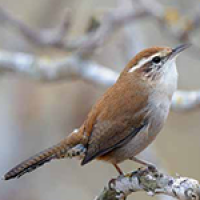
Bewick's Wren
- Thryomanes bewickii
- Length: 4½-5¼”
Flitting through parkland open forest and scrubby chaparral, or probing around your house, the always-curious Bewick’s wren inspects cracks and crevices for a possible insect meal or future nest site. The striking white eyebrow stripe distinguishes this year-round resident from other wrens. The Bewick’s long tail is usually held in a stiff, vertical tilt and waved about threateningly as the wren scolds territorial intruders. As a loud singer, this wren produces a complex and variable collection of burr-like buzzing, ending in a long, sweet trill.
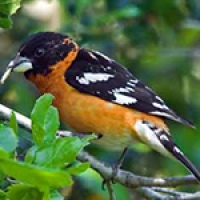
Black-headed Grosbeak
- Pheucticus melanocephalus
- Length: 7-8”
A major celebrity of the songbird world, the black-headed grosbeak’s spectacular color and robust size add to the joy of hearing its rich, warbling song (similar, but more complex than the American robin’s song). Black-headed grosbeaks are most common in oak woodlands, streamside habitats, and among groves of conifers. Consuming both insects and seeds, grosbeaks sometimes appear at backyard feeding stations, where they dash in to snatch a seed before shyly disappearing into nearby vegetation.
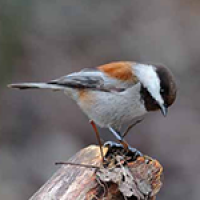
Chestnut-backed Chickadee
- Poecile rufescens
- Length: 4-4½”
Naturalist Aldo Leopold once called the chickadee a “small bundle of large enthusiasms.” Partial to treetops, these lively birds dangle fearlessly like tiny acrobats as they work to extract insects. Look for a tiny bird with a black cap and bib, and rust-colored back and sides. Chickadees are quite vocal birds, calling to one another often as they forage with a cheerful raspy chickadee-dee. Both male and female care for the young. Sunflower seeds and suet attract them to backyard feeders.
Golden-crowned Sparrow

Hermit Thrush
- Catharus guttatus
- Length: 6-7”
The song of this small, spotted brown thrush is usually heard in forests and is considered by many to be among the most beautiful of any songbird. Described as “flute-like” and liquid in nature, the hermit’s exquisite song must be heard to be believed. A sharply pointed bill, distinct dark spots on the creamy breast, rust-red rump and tail, and nervous wing-flicking behavior help identify this inconspicuous bird that will thrill you with its voice.

House Finch
Lesser Goldfinch
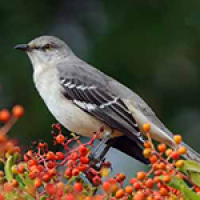
Northern Mockingbird
- Mimus polyglottos
- Length: 8-10”
A neighborhood and parkland favorite, the mockingbird has literally hundreds of songs in its repertoire. Its scientific name means “many-tongued mimic.” In addition to composing his own brilliant vocal productions, the male mockingbird imitates other birds and animals, car alarms, and a host of other inanimate noise makers. Expressing his mid-winter through summer-time passion with wild abandon, the male often sings loudly at night. Sleekly elegant in gray plumage with white wing patches, mockingbirds eat insects and berries and can be easily attracted to backyard feeders.
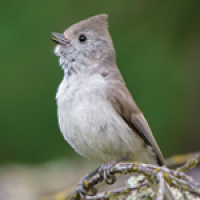
Oak Titmouse
- Baeolophus inornatus
- L 5-5½”
The head-feathers that point up into a crest make this otherwise plain and greyish bird easy to recognize. Its unique, loud, and jubilant teedle-ee teedle-ee song has been called “the heart and soul of the oak forest.” Its frequent call, however, sounds a lot like a chickadee. Just as fun to watch as to listen to, the oak titmouse is energetic in its quest for insects and seeds as it hops around branches of trees, especially oaks. Sometimes it uses its beak to loudly crack open seeds and acorns.
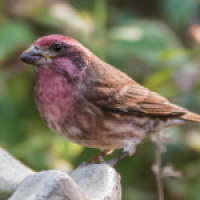
Purple Finch and House Finch
- Haemorhous purpureus and Thryomanes bewickii
- Length: 5-6½”
Two different species that are sometimes hard to tell apart, the males of both purple and house finches belt out a long and cheerful song. Purple finches are misnamed since the male’s bright red has only a subtle rosy tint, which extends further down on its body compared with the house finch. House finch males have a truer red color and dark streaking on their breast. Contrary to their name, they live in a wide variety of habitats as well as around houses, and they are generally more common than the forest-dwelling purple finches. Both eat lots of seeds, berries and flower buds, while the purple finch eats more insects, especially in summer.
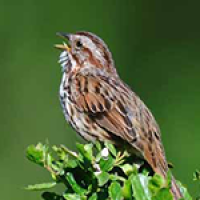
Song Sparrow
- Melospiza melodia
- Length: 5-7”
At first glance the song sparrow seems a rather unassuming “little brown bird.” Its most distinctive field mark is the dark spot centered on the streaked brown breast. However, when the male of this species belts out his sweet and highly complex springtime song, he lays legitimate claim to the title “songbird.” When flushed from its streamside habitat, this sparrow pumps its tail vigorously as it flies low and zips back into hiding. Coyote Hills Regional Park and other shoreline parks along San Francisco Bay provide critical habitat for a special race of this species, the Alameda salt marsh song sparrow. This bird is listed by the state as a “species of special concern.”
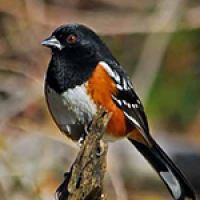
Spotted Towhee
- Pipilo maculatus
- Length: 7-8½”
This large, colorful sparrow has a call like a door-bell buzzer, and a song that is a simple, light-hearted trill. Spending much of its time feeding on the ground underneath dense bushes, the towhee noisily scratch-kicks dry leaf litter to uncover hidden seeds. You will usually hear it long before it appears in the open, but seeing its black, rust-red, and crisp white coloring is worth the wait.
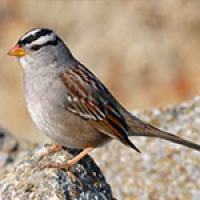
White-crowned Sparrow
- Zonotrichia leucophrys
- Length: 6-7”
Plump and striking in its appearance, the white-crowned sparrow is a common visitor to residential seed feeders, and a year-round resident in the Bay Area. The bold black and white crown stripes are key diagnostic markings for this species, which often feed on the ground. Look for white-crowns energetically scratch-kicking through leaf-litter for seeds as you hike parkland trails. In the winter white-crowns often mix with golden-crowned sparrows, whose descending “oh dear me” whistling song is a familiar wintry sound.

Wilson's Warbler
- Wilsonia pusilla
- Length: 4½-5”
This dazzling, yellow warbler can be easy to spot, but difficult to positively identify because it virtually never stops moving. A tireless insectivore, the Wilson’s warbler seems to chase bugs constantly by gleaning, probing, and suddenly flitting upward to snatch airborne prey. While the yellow and olive-green female Wilson’s might be confused with another warbler species, the silky black cap of the male is distinctive. They are fond of water; you may get a good look at this bird by pausing quietly near the shallow edge of a stream or pond.
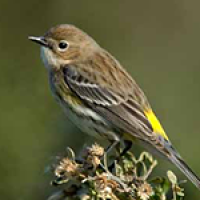
Yellow-rumped Warbler
- Dendroica coronata
- Length: 5-6”
One of the most abundant warbler species, this dazzling bird is identified by its bright yellow rump patch. The male “butter butt” in breeding plumage also has bright yellow on the sides, throat, and crown as well as black (sometimes dark blue-gray) on the breast and cheeks. His song is a sweet warble. Look for yellow-rumps foraging for insects in trees and tall shrubs, sometimes flying up to catch them in the air.